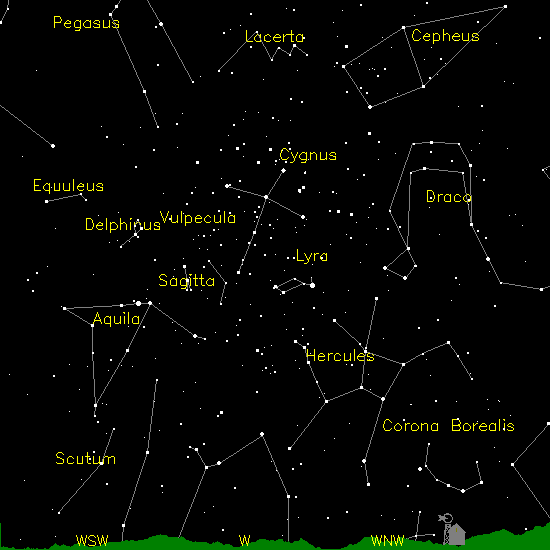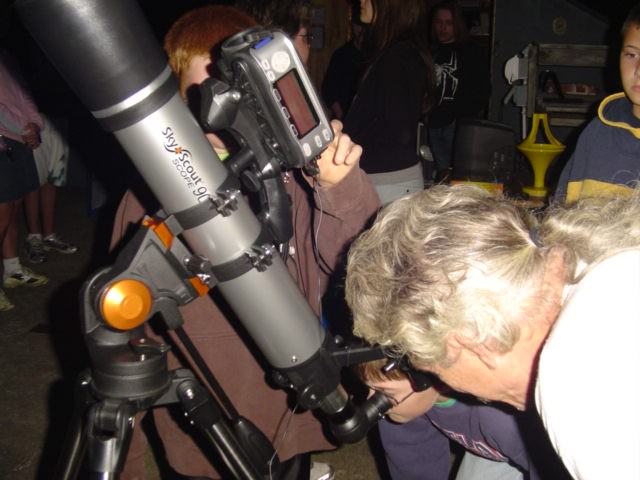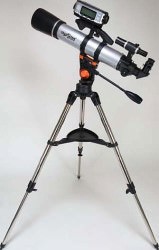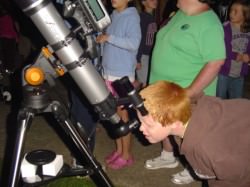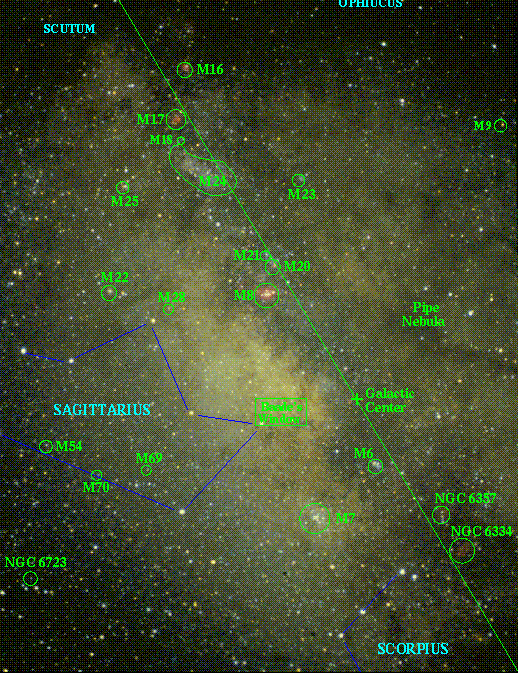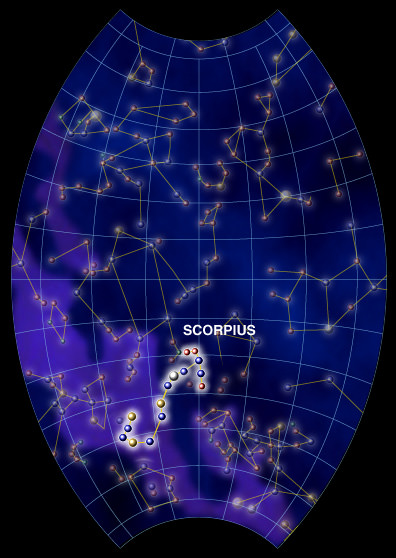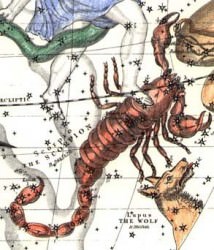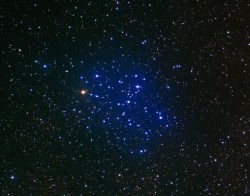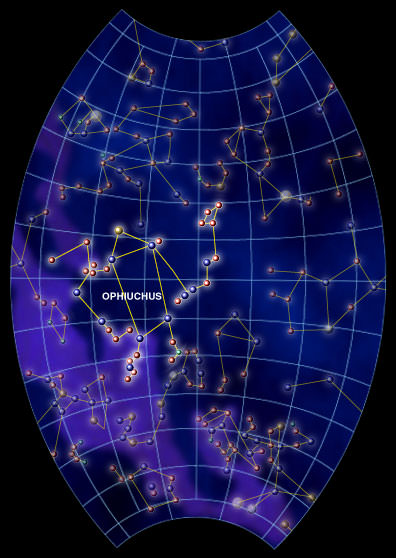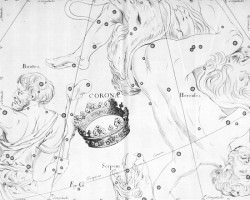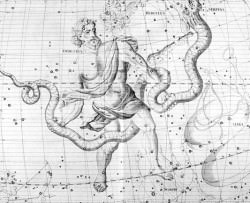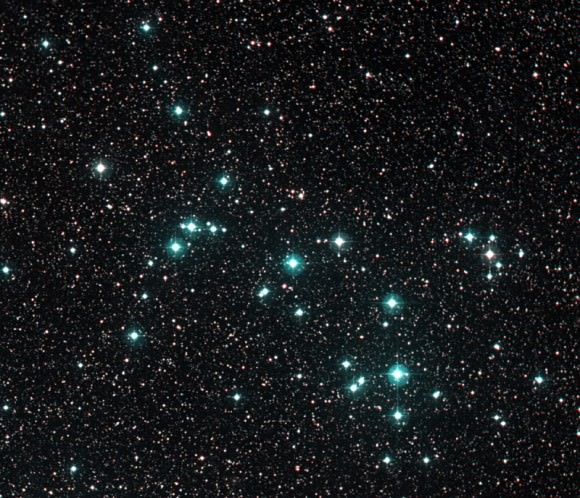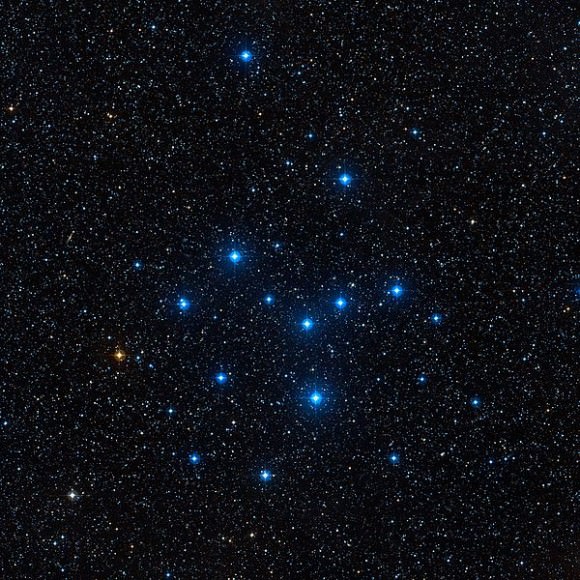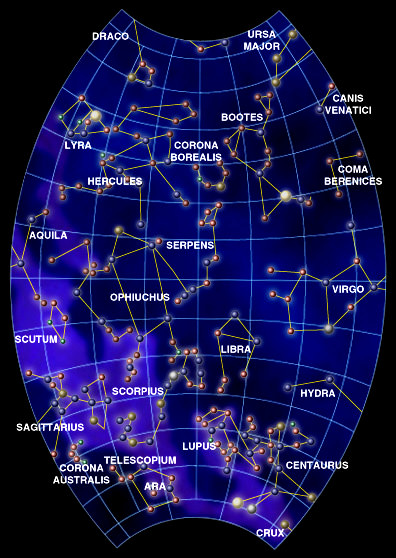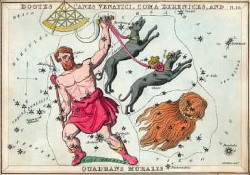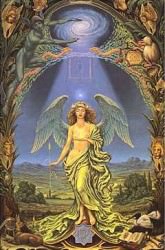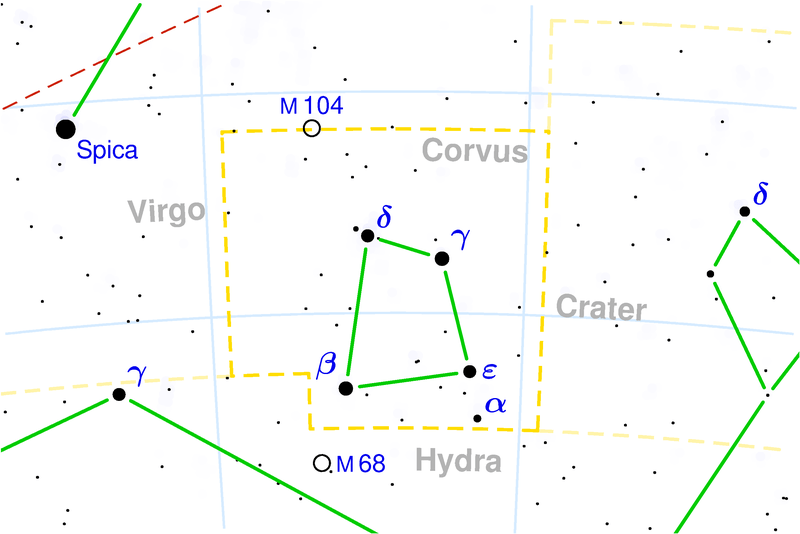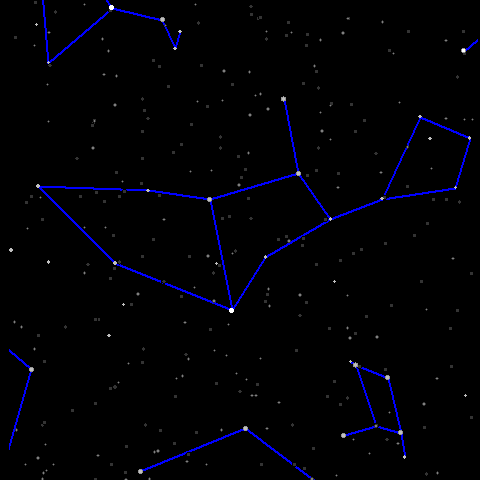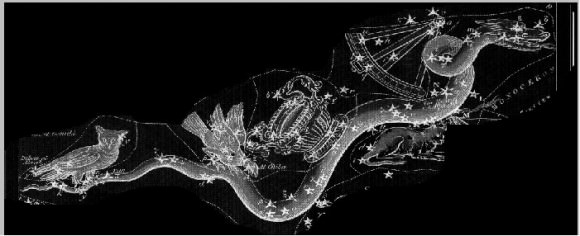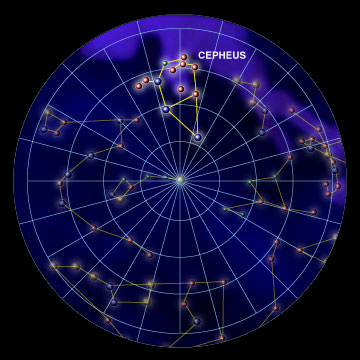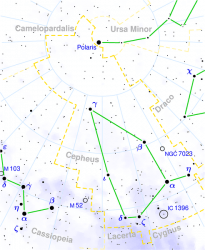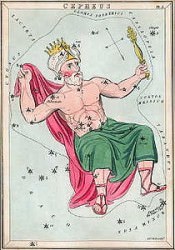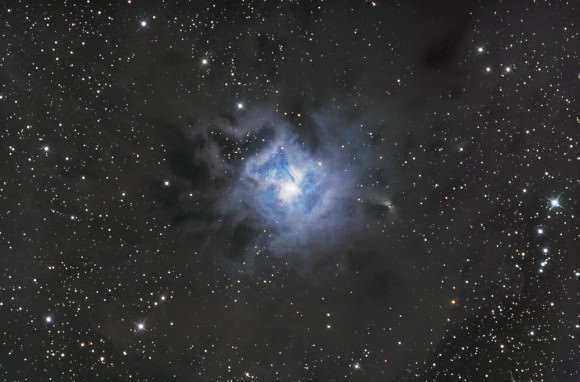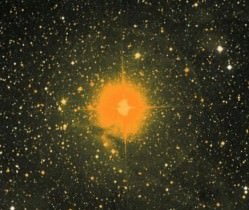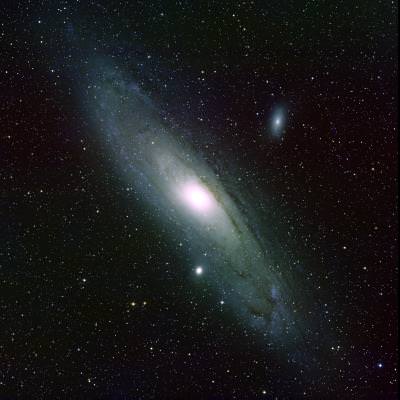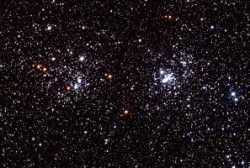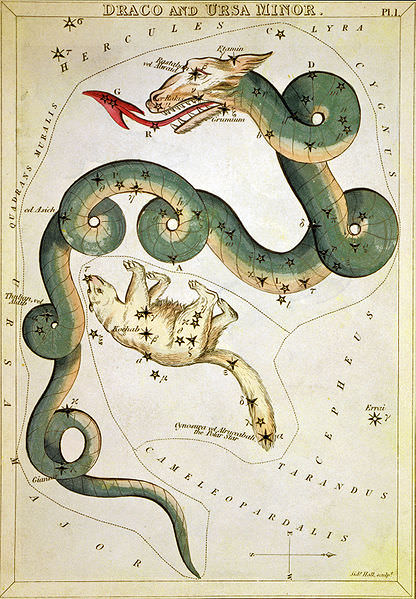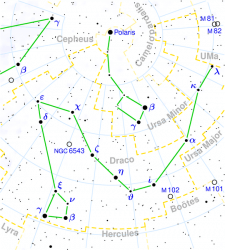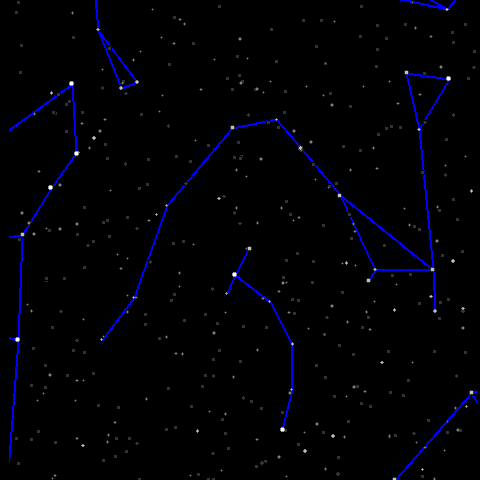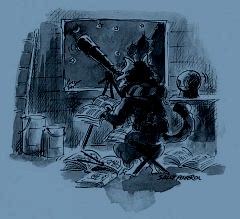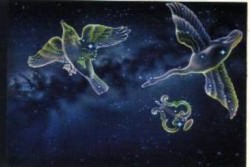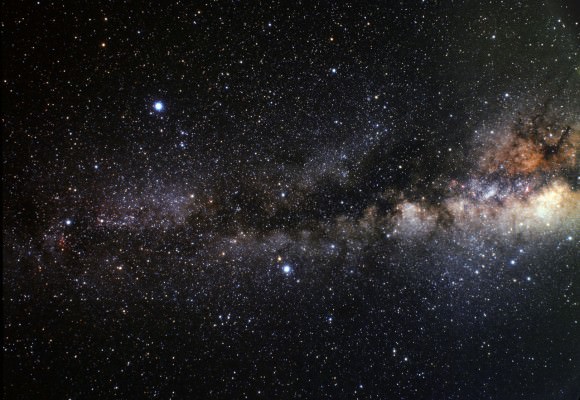Ah, yes… The skies have long been dark and the constellations have been on the move since the last time we’ve visited! Hercules now stands overhead when darkness falls. Summer Bugs and Scorpius are already going west of the meridian and Ophiuchus, the “Snake Charmer” has taken its place. In the southern hemisphere, they are tolerating winter – but the nights are warm in the north and with them comes our finest times of viewing our own Milky Way galaxy’s spiral arm… Sagittarius.
Are you ready to learn more? Then for most of you, the journey will begin as the sky starts to darken. Do you remember the herdsman, Bootes? His marker star, Arcturus, has now moved from overhead to the high west for most locations. How about the Summer Triangle? Instead of waiting for hours for it to arrive, those three bright stars show clearly as well risen to the east and high east. Do you remember the Scorpion? It’s here, too… And as the sky gets truly dark, you won’t be able to miss sparkling red Antares or the distinctive pattern of Scorpius as it sits against the southern skyline slightly to the southwest.
But, we promised you summer, didn’t we? That’s right. And no summer would be complete without some starry nights and peering into the center of our own Milky Way Galaxy. We’ll begin by identifying the southernmost star of the Summer Triangle, Altair, and the Aquila constellation. Its distinctive “T” shape shows in even relatively light polluted areas! Beginning with Altair (Alpha Scu), count four stars down the back towards the south. At the end of this chain, you will see two stars close together. Starhop almost this same distance west with your binoculars and listen to the wind….
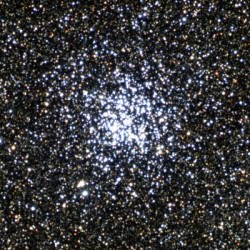 “What Summer would be complete without looking for a beautiful flock of Wild Ducks taking flight against the starry night? You’ll find this sparkling open cluster just south of another sky-bird, Aquila. Count down four stars to Lambda Scuti…” In binoculars it will show as a distinctive diamond-shaped compression of star field and will begin some resolution. In the finderscope it will appear as a small hazy patch. Even in a small telescope it will resolve into a glorious open cluster and will show hundreds of stars to larger aperture. At around 220 million years old, Messier 11 is one of the richest and most compact of the known open clusters, containing about 2900 stars. Its brightest and hottest main sequence stars are of spectral type B8 and it also contains many yellow and red giant stars. Speeding away from us at 22 kilometers per second, a total of 82 variable stars have so far been discovered amidst its vast population!
“What Summer would be complete without looking for a beautiful flock of Wild Ducks taking flight against the starry night? You’ll find this sparkling open cluster just south of another sky-bird, Aquila. Count down four stars to Lambda Scuti…” In binoculars it will show as a distinctive diamond-shaped compression of star field and will begin some resolution. In the finderscope it will appear as a small hazy patch. Even in a small telescope it will resolve into a glorious open cluster and will show hundreds of stars to larger aperture. At around 220 million years old, Messier 11 is one of the richest and most compact of the known open clusters, containing about 2900 stars. Its brightest and hottest main sequence stars are of spectral type B8 and it also contains many yellow and red giant stars. Speeding away from us at 22 kilometers per second, a total of 82 variable stars have so far been discovered amidst its vast population!
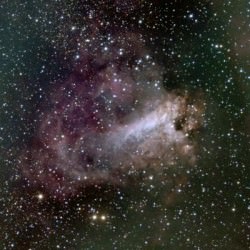 “If you like beach parties, then why not capture your own lobster? Although it is sometimes known as the Omega Nebula, Messier 17 looks like a ghostly green lobster just waiting on your pot!” How do you find it? For binoculars and image correct finderscopes, try starting with the constellation of Aquila and begin tracing the stars down the eagle’s back to Lambda – just like you did for M11. When you reach that point, continue to extend the line through to Alpha Scuti, then southwards towards Gamma Scuti. M17 is slightly more than 2 degrees (about a finger width) southwest of this star. If you are in a dark sky location, you can also identify it easily in binoculars by starting at the M24 “Star Cloud” north of Lambda Sagittari (the teapot lid star) and simply scan north. This nebula is bright enough to even cut through moderately light polluted skies with ease, but don’t expect to see it when the Moon is nearby. You’ll enjoy the rich star fields combined with an interesting nebula in binoculars, while telescopes will easily begin resolution of interior stars.
“If you like beach parties, then why not capture your own lobster? Although it is sometimes known as the Omega Nebula, Messier 17 looks like a ghostly green lobster just waiting on your pot!” How do you find it? For binoculars and image correct finderscopes, try starting with the constellation of Aquila and begin tracing the stars down the eagle’s back to Lambda – just like you did for M11. When you reach that point, continue to extend the line through to Alpha Scuti, then southwards towards Gamma Scuti. M17 is slightly more than 2 degrees (about a finger width) southwest of this star. If you are in a dark sky location, you can also identify it easily in binoculars by starting at the M24 “Star Cloud” north of Lambda Sagittari (the teapot lid star) and simply scan north. This nebula is bright enough to even cut through moderately light polluted skies with ease, but don’t expect to see it when the Moon is nearby. You’ll enjoy the rich star fields combined with an interesting nebula in binoculars, while telescopes will easily begin resolution of interior stars.
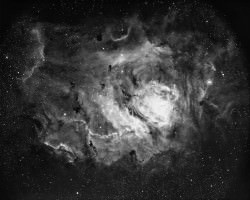 “Summer nights mean a chance to swim, and what more peaceful way than in the Blue Lagoon? Get out your binoculars and explore M8 – the Lagoon Nebula….” Although the constellation of Sagittarius is recognized as the Archer, it is most familiar as an asterism known as the ‘teapot’. Where skies are dark, its simple house-like shape appears like a teapot in the sky and the steam escaping the spout in the Milky Way. Finding Messier 8 in binoculars or a telescope is easy in a dark location, because you only need to start at the tip of the teapot’s spout and move your optics due north until this large, bright nebula appears. However, not everyone is blessed with dark skies and finding M8 from an urban location can be a little more difficult. From a well-lighted situation, both the teapot lid star (Lambda) and Alpha Scorpii (Antares) show well. You’ll find M8 just slightly north about 1/4 of the distance between Lambda and Alpha. In binoculars it will be quite bright and you’ll see the beginnings of its embedded open cluster – while a telescope of any size will resolve the cluster and bring up wonderful details in the wispy nebula. Large aperture should also look for accompanying dark nebula, too. Be aware that although it is bright, well-lit situations will greatly reduce contrast and a moonlit night or city lights will make it very difficult to find. Because of the Lagoon Nebula’s large apparent size, use low magnification to see the full extent of the nebula, but be sure to up the power to study its many features!
“Summer nights mean a chance to swim, and what more peaceful way than in the Blue Lagoon? Get out your binoculars and explore M8 – the Lagoon Nebula….” Although the constellation of Sagittarius is recognized as the Archer, it is most familiar as an asterism known as the ‘teapot’. Where skies are dark, its simple house-like shape appears like a teapot in the sky and the steam escaping the spout in the Milky Way. Finding Messier 8 in binoculars or a telescope is easy in a dark location, because you only need to start at the tip of the teapot’s spout and move your optics due north until this large, bright nebula appears. However, not everyone is blessed with dark skies and finding M8 from an urban location can be a little more difficult. From a well-lighted situation, both the teapot lid star (Lambda) and Alpha Scorpii (Antares) show well. You’ll find M8 just slightly north about 1/4 of the distance between Lambda and Alpha. In binoculars it will be quite bright and you’ll see the beginnings of its embedded open cluster – while a telescope of any size will resolve the cluster and bring up wonderful details in the wispy nebula. Large aperture should also look for accompanying dark nebula, too. Be aware that although it is bright, well-lit situations will greatly reduce contrast and a moonlit night or city lights will make it very difficult to find. Because of the Lagoon Nebula’s large apparent size, use low magnification to see the full extent of the nebula, but be sure to up the power to study its many features!
Messier Object 8 is a giant interstellar cloud. An emission nebula is a localized region of ionized gas which emits light in different colors at wavelengths not always visible to the human eye. Its energy source is ionization from high-energy photons emitted from a nearby hot star, which causes it to glow – much like the heating coil on an electric stove. The colors you see photographically depend on the chemical composition and how much it is being ionized. Most nebulae contain an abundance of hydrogen, which doesn’t require much energy to be ionized and appears red. Where more energy is available from more powerful stars, other elements will be ionized and green and blue hues will appear. To our human eyes, we see nebulae like M8 is gray, or gray/green… Doubly ionized oxygen! Many emission nebulae like M8 often have dark areas in them where no stars or light seems to appear. We refer to these as ‘dark nebula’ but they’re really just clouds of dust which block the light.
The Lagoon Nebula is about 5200 light years away and covers an area of space about 140 by 60 light years. Its brightest portion is often called the “Hourglass Nebula” and it’s a region where new star formation is occurring. Inside you’ll also see young open star cluster NGC 6530. According to information, it may be situated just slightly in front of the nebula from our perspective, but interstellar reddening shows the nebula is also involved with the cluster. M8 is also famous for its Bok globules – dark, collapsing clouds of protostellar material!
 “Are you ready to go catch some lightning bugs? Then you’ll find a whole swarm of them just waiting for you near the top of the celestial tea kettle.” From its position almost on the ecliptic plane, bright globular cluster M22 is easy to find in optics of all sizes… The most important clue is simply identifying the Sagittarius “teapot” shape! Once you’ve located it, just chose the “lid” star, Lambda (Kaus Borealis) and look about a finger width (2 degrees) due northeast. In binoculars, if you center Lambda, M22 will appear in the 10:00 region of your field of view. In a finderscope, you will need to hop from Lambda northeast to 24 Sagittari and you’ll see it as a faint fuzzy nearby also to the northeast. From a dark sky location, Messier Object 22 can also sometimes be spotted with the unaided eye! No matter what size optics you use, this large, very luminous ball of stars is quite appealing. A joy to binocular users and an exercise in resolution to telescopes. Drifting along in space some 10,400 light years from our solar system, M22 shares common ground with a lot of other clusters of its type. It’s true that it is a gravitationally bound sphere of stars and that most of its stars are all about the same age. It’s also true that it’s part of our galactic halo and may once have been part of a galaxy that our Milky Way cannibalized… But it’s there that the similarities end. There’s a lot more to this ball of stars that’s receding away from us at 149 kilometers per second than meets the eye.
“Are you ready to go catch some lightning bugs? Then you’ll find a whole swarm of them just waiting for you near the top of the celestial tea kettle.” From its position almost on the ecliptic plane, bright globular cluster M22 is easy to find in optics of all sizes… The most important clue is simply identifying the Sagittarius “teapot” shape! Once you’ve located it, just chose the “lid” star, Lambda (Kaus Borealis) and look about a finger width (2 degrees) due northeast. In binoculars, if you center Lambda, M22 will appear in the 10:00 region of your field of view. In a finderscope, you will need to hop from Lambda northeast to 24 Sagittari and you’ll see it as a faint fuzzy nearby also to the northeast. From a dark sky location, Messier Object 22 can also sometimes be spotted with the unaided eye! No matter what size optics you use, this large, very luminous ball of stars is quite appealing. A joy to binocular users and an exercise in resolution to telescopes. Drifting along in space some 10,400 light years from our solar system, M22 shares common ground with a lot of other clusters of its type. It’s true that it is a gravitationally bound sphere of stars and that most of its stars are all about the same age. It’s also true that it’s part of our galactic halo and may once have been part of a galaxy that our Milky Way cannibalized… But it’s there that the similarities end. There’s a lot more to this ball of stars that’s receding away from us at 149 kilometers per second than meets the eye.
Messier 22 contains at least 70,000 individual stars – and out of those? Only 32 are variable stars. It spans an incredible 200 light years in diameter and ranks 4th in brightness against all the known globular clusters in our galaxy. And four is its lucky number… Because it is also one of only four globular clusters known to contain a planetary nebula. But is that all? Not hardly. Recent Hubble Space Telescope investigations of Messier 22 have led to the discovery of an astonishing discovery. It would appear that there’s planet-sized objects floating around in there about 80 times the mass of Earth!
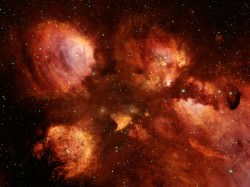 “Summer fun means including the whole family and it would appear a curious cat has been tracking around the center of our Milky Way Galaxy! Get out your telescope and look for the Cat’s Paw Nebula, NGC 6334, just above the Scorpion’s tail.” Nebulae are perhaps as famous for being identified with familiar shapes as perhaps cats are for getting into trouble! Still, no known cat could have created the vast Cat’s Paw Nebula visible in Scorpius. At 5,500 light years distant, Cat’s Paw is an emission nebula with a red color that originates from an abundance of ionized hydrogen atoms. Alternatively known as the Bear Claw Nebula or NGC 6334, stars nearly ten times the mass of our Sun have been born there in only the past few million years.
“Summer fun means including the whole family and it would appear a curious cat has been tracking around the center of our Milky Way Galaxy! Get out your telescope and look for the Cat’s Paw Nebula, NGC 6334, just above the Scorpion’s tail.” Nebulae are perhaps as famous for being identified with familiar shapes as perhaps cats are for getting into trouble! Still, no known cat could have created the vast Cat’s Paw Nebula visible in Scorpius. At 5,500 light years distant, Cat’s Paw is an emission nebula with a red color that originates from an abundance of ionized hydrogen atoms. Alternatively known as the Bear Claw Nebula or NGC 6334, stars nearly ten times the mass of our Sun have been born there in only the past few million years.
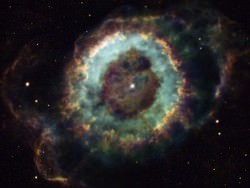 “What Summer night would not be complete without telling a ghost story around the campfire!It’s time to take a look at Telescopium – the telescope – and find NGC 6369.” This pretty planetary nebula was discovered by astronomer William Herschel as he used a telescope to explore the constellation Ophiuchus. It’s called a planetary nebula because it is round and planet-shaped – but it’s far fainter. For that very reason, it’s often called the Little Ghost Nebula! What is is a sun-like star at the end of its life… shedding its outer layers and expanding into space. During this time, the star’s core begins to shrinks until it ends up as a white dwarf star. Once transformed, the white dwarf star then lights the “left over” nebula material. Over 2,000 light-years away, the Little Ghost Nebula shows us what make eventually become of our own Sun in another 5 billion years!
“What Summer night would not be complete without telling a ghost story around the campfire!It’s time to take a look at Telescopium – the telescope – and find NGC 6369.” This pretty planetary nebula was discovered by astronomer William Herschel as he used a telescope to explore the constellation Ophiuchus. It’s called a planetary nebula because it is round and planet-shaped – but it’s far fainter. For that very reason, it’s often called the Little Ghost Nebula! What is is a sun-like star at the end of its life… shedding its outer layers and expanding into space. During this time, the star’s core begins to shrinks until it ends up as a white dwarf star. Once transformed, the white dwarf star then lights the “left over” nebula material. Over 2,000 light-years away, the Little Ghost Nebula shows us what make eventually become of our own Sun in another 5 billion years!
Enjoy your summer evenings….
Many thanks to these great resources for the images! Sagittarius Region Map courtesy of Bill Keel of the University of Alabama, M11, M17, M8, and M22 images courtesy of NOAO/AURA/NSF, NGC 6334 courtesy of Travis Rector, NOAO/AURA/NSF and the “Little Ghost” courtesy of the Hubble Heritage Team
 Over the next few days just after sunset, the slender crescent Moon will glide silently between two constellations that represent birds and help you to locate them with ease. While you’re out, listen to the voices on the wind… “Look to the southwest for Aquila the Eagle. Perhaps you recognize it as is one of the three constellations from which we learned the stars of the Summer Triangle? Aquila was known to the Romans as Vultur volans the ‘Flying Vulture’. Now instead of flying high in the sky, it is headed west. Look for a straight line of three stars almost level with the horizon. The center and brightest of these three stars is Altair and they represent the Eagle’s wings. The head of the Eagle – Lambda – is a much dimmer star which stretches off to the southwest to stars from Altair. Its proper name is Al Thalimain, which means the two ostriches! But there’s still more… If you look again at Altair, whose Arabic name means ‘the bird’, you’ll see another fairly bright star to the south. That’s Beta, or better known as Alshain. In Arabic, it means falcon!”
Over the next few days just after sunset, the slender crescent Moon will glide silently between two constellations that represent birds and help you to locate them with ease. While you’re out, listen to the voices on the wind… “Look to the southwest for Aquila the Eagle. Perhaps you recognize it as is one of the three constellations from which we learned the stars of the Summer Triangle? Aquila was known to the Romans as Vultur volans the ‘Flying Vulture’. Now instead of flying high in the sky, it is headed west. Look for a straight line of three stars almost level with the horizon. The center and brightest of these three stars is Altair and they represent the Eagle’s wings. The head of the Eagle – Lambda – is a much dimmer star which stretches off to the southwest to stars from Altair. Its proper name is Al Thalimain, which means the two ostriches! But there’s still more… If you look again at Altair, whose Arabic name means ‘the bird’, you’ll see another fairly bright star to the south. That’s Beta, or better known as Alshain. In Arabic, it means falcon!”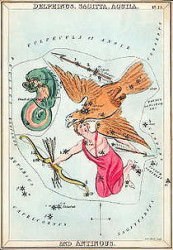 “To the ancient Greeks, Aquila was thought of as the feathered servant of Zeus. It was the Eagle who was in charge of holding the god’s thunderbolts and doing his chores. Aquila was also considered by some cultures to be the great eagle who ate Prometheus’ liver for giving fire to humans! To the Indians, the line of three stars which includes Altair is thought to be the footprints of the god Vishnu. Some Asian traditions see the bright star Vega as the Weaving-Princess who married Altair, the shepherd. In the Chinese love story of Qi Xi, Niu Lang (Altair) and his two children (Beta and Gamma Aquilae) are separated forever from their wife and mother Zhi Nu (Vega) who is on the far side of the river, the Milky Way.”
“To the ancient Greeks, Aquila was thought of as the feathered servant of Zeus. It was the Eagle who was in charge of holding the god’s thunderbolts and doing his chores. Aquila was also considered by some cultures to be the great eagle who ate Prometheus’ liver for giving fire to humans! To the Indians, the line of three stars which includes Altair is thought to be the footprints of the god Vishnu. Some Asian traditions see the bright star Vega as the Weaving-Princess who married Altair, the shepherd. In the Chinese love story of Qi Xi, Niu Lang (Altair) and his two children (Beta and Gamma Aquilae) are separated forever from their wife and mother Zhi Nu (Vega) who is on the far side of the river, the Milky Way.”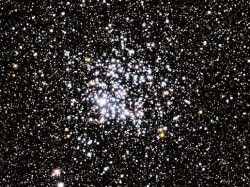 “If your skies are dark early enough and you have an open western horizon, you can use your binoculars to look for a flight of ‘Wild Ducks’ headed west, too. You will find it just a little north and west of the head of the Eagle, Lambda. This compact, open star cluster is also known as Messier Object 11 or NGC 6705. While you may only see a few stars in this 220 million years old gathering of suns, the cluster proper contains almost 2900 stars. Full of yellow and red giant stars these ‘ducks’ aren’t just migrating, they’re speeding away from us at 22 kilometers per second!”
“If your skies are dark early enough and you have an open western horizon, you can use your binoculars to look for a flight of ‘Wild Ducks’ headed west, too. You will find it just a little north and west of the head of the Eagle, Lambda. This compact, open star cluster is also known as Messier Object 11 or NGC 6705. While you may only see a few stars in this 220 million years old gathering of suns, the cluster proper contains almost 2900 stars. Full of yellow and red giant stars these ‘ducks’ aren’t just migrating, they’re speeding away from us at 22 kilometers per second!” Now, let’s go a bit higher and take a look at big bird – Cygnus the Swan. Sometimes folks refer to this constellation as the Northern Cross because of its shape. Do you recognize it as also being a member of the Summer Triangle? The tail of the Swan is bright star Deneb, Arabic for ‘tail’. Deneb is a very young, bright blue supergiant star and you’ll see three stars in a row below it – Gamma in the center, Delta to the north and Epsilon to the south. Two stars west of Gamma is Beta – Albireo – the beak of the Swan. If you have a telescope or higher power binoculars, take a look! Albireo is really two stars. This is what is known as a binary star, and you’ll find the pair has a very noticeable orange and blue color contrast.”
Now, let’s go a bit higher and take a look at big bird – Cygnus the Swan. Sometimes folks refer to this constellation as the Northern Cross because of its shape. Do you recognize it as also being a member of the Summer Triangle? The tail of the Swan is bright star Deneb, Arabic for ‘tail’. Deneb is a very young, bright blue supergiant star and you’ll see three stars in a row below it – Gamma in the center, Delta to the north and Epsilon to the south. Two stars west of Gamma is Beta – Albireo – the beak of the Swan. If you have a telescope or higher power binoculars, take a look! Albireo is really two stars. This is what is known as a binary star, and you’ll find the pair has a very noticeable orange and blue color contrast.”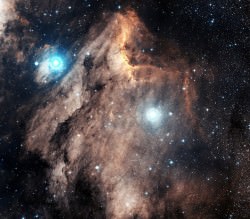 “Is that all the birds in Cygnus? Not hardly. Although it is very hard to see optically, there is another feathered friend very close to Deneb… the Pelican Nebula! This neon night bird is filled with stars being born and clouds of gas evolving. The young stars inside the cloud are very active and their energy is turning the cold gas into hot gas, causing it to glow and spread outward. The ridge of cold gas being pushed away from the 2,000 light-year year distant warm gas cloud is called an ionization front. Dark dust clouds are what shapes Pelican’s eye and long bill, while the ionization front make up the curved shape of the head and neck.”
“Is that all the birds in Cygnus? Not hardly. Although it is very hard to see optically, there is another feathered friend very close to Deneb… the Pelican Nebula! This neon night bird is filled with stars being born and clouds of gas evolving. The young stars inside the cloud are very active and their energy is turning the cold gas into hot gas, causing it to glow and spread outward. The ridge of cold gas being pushed away from the 2,000 light-year year distant warm gas cloud is called an ionization front. Dark dust clouds are what shapes Pelican’s eye and long bill, while the ionization front make up the curved shape of the head and neck.”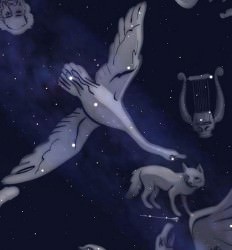 “So where did the Swan come from? There are many legends. To the ancient Greeks, Cygnus is Zeus in disguise, flying his way across the sky to win the heart of Leda, the mother of Helen of Troy and the Gemini twins. Perhaps Cygnus is Orpheus, who was placed in the sky along with his harp (Lyra) after he was murdered. In one myth, Cygnus is a friend of Phaethon, the son of Sun god Apollo, who crashed the sky chariot while driving along the Milky Way. It is said that Zeus turned Cygnus into a swan for his heroic attempts to save Phaethon from the starry river. Perhaps Cygnus is the son of Neptune – saved by his father who turned him into a swan before he was defeated by Achilles. But according to Chinese mythology, Cygnus is the magpie bridge. And you know what magpies are, don’t you? That’s right… Birds!”
“So where did the Swan come from? There are many legends. To the ancient Greeks, Cygnus is Zeus in disguise, flying his way across the sky to win the heart of Leda, the mother of Helen of Troy and the Gemini twins. Perhaps Cygnus is Orpheus, who was placed in the sky along with his harp (Lyra) after he was murdered. In one myth, Cygnus is a friend of Phaethon, the son of Sun god Apollo, who crashed the sky chariot while driving along the Milky Way. It is said that Zeus turned Cygnus into a swan for his heroic attempts to save Phaethon from the starry river. Perhaps Cygnus is the son of Neptune – saved by his father who turned him into a swan before he was defeated by Achilles. But according to Chinese mythology, Cygnus is the magpie bridge. And you know what magpies are, don’t you? That’s right… Birds!”
